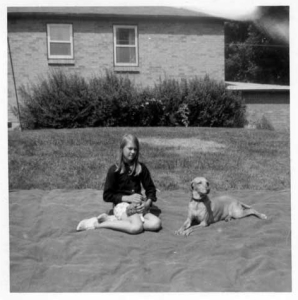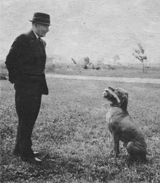“I have been blessed to have this breed in my life for over fifty years, and they continue to enrich my life every day.”
-Suzanne Towne
aa
I was born and grew up in western New York outside the Buffalo/Niagara Falls area. We lived in a small farming community settled by German immigrants, including my grandparents who lived across the street. A plethora of magnificent pheasants made their home near the cornfields on and surrounding our property, and my father was an avid hunter. He hunted every day of the season and had only to cross the back yard to have access to enough pheasants to fill his daily limit. My father had several varieties of upland bird dogs and frequently complained, “Not one of these dogs has the stamina to go a full day.” Each hunting season he sold several dogs and bought new ones. None of them were ever allowed in the house.
In 1957, my father told my mother she could buy us a puppy. It was understood that this would be a family pet that could live in the house. Filled with excitement, my mother went looking for an Apricot Poodle in the local newspaper. But, as fate would have it, another advertisement caught her eye instead: “Magyar Vizsla. Excellent bird dog. Guarded the crown jewels of Hungary. Puppies now available. Please call. ”
The ad captivated my mother so much she felt she had to call that very day, and she spent two hours on the phone talking to the breeder. She made an appointment for the following morning and took my grandfather with her to see the litter. My mother remembers taking one look at those beautiful puppies with the strange sounding name and falling completely in love with them. The only problem was the $100 price tag. My grandfather, a man of very few words, lent her a portion of the money and said only this “Buy it.” And she did.
Our very first Vizsla arrived home on the afternoon of my parent’s seventh wedding anniversary. My father, home from a long day of hunting, spied the puppy in a brown box in the kitchen and quizzically asked, “What’s that?” My mother said proudly, “It’s a Magyar Vizsla.” We named her “Tina Our Pride” and quickly, she lived up to her name.
Tina began pointing at three months of age in the cornfield next to our house. By five months of age, she was hunting pheasants that were almost as large as she was! My father not only ceased his complaining but also told us Tina was “the finest hunting companion he’d ever had and the most intelligent.” What pleased him most was her stamina. Tina could hunt every day all day long without tiring and would literally leap in the air when my dad put on his hunting gear in the mornings.
She was also the perfect family pet. Tina had her own chair in our living room, eagerly played hide and seek with us, patiently allowed us to dress her up in all sorts of silly outfits and was our constant companion in outdoor activities. No matter the season, she always ran to meet us with a wagging tail and a lick for our faces. My mother recalls that Tina would hear us screaming and laughing on our sleds, and, thinking we must be in some kind of trouble, she would race down the hill to rescue us and anxiously lick us to make sure we were OK. At bedtime, my siblings and I vied for the privilege of sleeping with Tina, but my mother remembers it was Tina who ultimately decided where she slept.
I was four years old when Tina joined our family, and that was the beginning of my love affair with the Vizsla, a breed that has enriched my life for over 50 years.
“Rex and Sari. Jena Dus. Jutka. These are famous names not only in Vizsla history, but also in our Tina’s pedigree.”
A number of years after our family purchased Tina, my parents went to see a litter of Vizslas bred by a man named Jeno Dus. During their visit, they discovered that Jeno had emigrated from Hungary five years earlier in 1952, when Hungary was forced to capitulate to the Communists. He had settled in Hamburg, New York, which was about 40 miles from our home. Dus was a colonel in the Nationalists Hungarian Army and a possessor of the Hungarian knightly order. He was also the last director of the Vizsla Club of Hungary before he fled war-torn Europe. Just before he left, he hid the original stud books of the VCH, and to this day, they have never been found.
Tina Our Pride is Jutka and Pik’s granddaughter and, therefore, the great granddaughter of Rex and Sari!
After a most impressive visit, my father invited Jeno to join him for a hunt, and my mother remembers that on the morning Jeno came to our home, he brought her a box of chocolates and kissed her hand in the most gentlemanly, European manner. After a full day of hunting, Jeno exclaimed in his broken English: “Tina, she is a very fine hunting dog.” My parents never saw Jeno again but cherish the fond memories of their visits with him.
In 1962, Jeno was seriously injured in a tragic auto accident. He was rarely without his Vizslas, and my mother recalls the local newspaper reporting that on the day of the accident, Jeno’s dogs guarded him so protectively the emergency personnel could not reach him to administer aid. Jeno’s son had to be called to take control and comfort the dogs, while Jeno was rushed to the hospital. He died shortly after surgery, and my parents still remember the sadness and shock of that day. Jeno’s death was a great loss to the Vizsla world in this country and his own.
“We didn’t know in 1957, what we now know about Tina Our Pride’s ancestry: She is the great granddaughter of Rex and Sari, the very first Vizslas bred in this country. ”
As an adult, I have come to cherish my past with this incredible breed. In researching the history of the breed and listening to my parents share their memories of Jeno Dus and his dogs, we discovered a common thread. In The Vizsla, Bernard C. Boggs writes about the very first litter bred in the United States in 1951 by Frank and Jane Tallman. The Tallman’s bitch, Sari (pronounced Shari) and a sire named Rex Del Gelsomino produced a beautiful litter of four females and two males: Duchess, Jutka. Queenie, Princess, Little Rex and Prince. Jeno Dus purchased Jutka. and in 1954, bred her to his male, Pik. The common thread mentioned above is Jutka.
Tina Our Pride is Jutka and Pik’s granddaughter and, therefore, the great granddaughter of Rex and Sari!
Our family felt honored to be part of the earliest beginnings of the Vizsla breed in America. My mother shared that when they had visited the litter at Jeno Dus’ home, there had been an older female Vizsla present. She doesn’t know if this was Jutka, but there is a very good chance that it was. My mother said quietly, “You know, it could have been her. I sure hope it was.” And so do I.
Tina won our hearts so completely, that we added several more Vizslas to our family over the years. My grandfather and several of my father’s hunting buddies also acquired Vizslas. One of these individuals still lives down the road from my family and has had Vizslas in his life for over 40 years. He bought one of my puppies a couple of years ago and I am honored to continue what my father started all those many years ago.
Tina Our Pride lived to be almost 16 before she left us, and I know today she is smiling down from heaven at me, proud of my love for her and all of the special Vizslas that continue to fill my life.

The Vizsla. bv Bernard C. Boggs (see Second Revised Edition, pages 27-33) and The Versatile Vizsla by Marion Coffman are excellent books on the Vizsla breed. Each covers the history of the Vizsla in this country and include information about Jeno Dus and Jutka, and the Talman’s Rex and Sari. See the Resources Section for more information.



